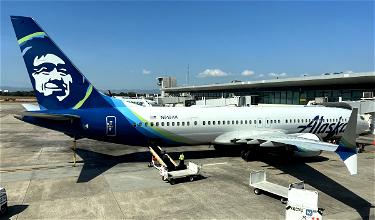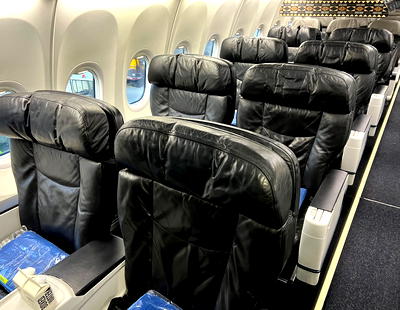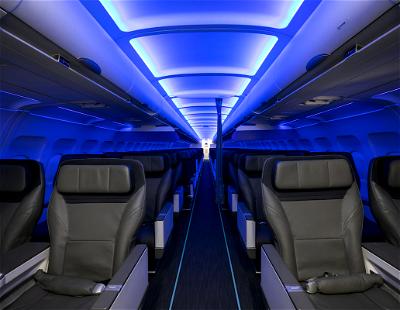While tail strikes happen every once in a while, two Alaska Airlines jets had tail strikes within minutes of one another, leading to all Alaska flights temporarily being grounded. The backstory here is pretty interesting, as reported by The Seattle Times.
In this post:
Two Hawaii-bound Alaska 737s have tail strikes
On the morning of January 26, 2023, two Alaska Boeing 737s had tail strikes six minutes apart, while departing Seattle for Hawaii:
- At 8:48AM, a Boeing 737 MAX 9 operating flight AS801 headed for Kona (KOA) had a tail strike
- At 8:54AM, a Boeing 737-900ER operating flight AS887 headed for Honolulu (HNL) had a tail strike
In each case, the pilots felt a slight bump during takeoff, while flight attendants at the back of the cabin heard a scratching noise. The planes quickly returned to Seattle, and landed safely.
While tail strikes happen every so often, it’s rare to see them back-to-back at the same airport, on the same kinds of routes, and with similar types of planes.
At this point, Alaska’s on-duty director of operations immediately paused all takeoffs for the airline:
“At that point, two in a row like that, that’s when I said, ‘No, we’re done. That’s when I stopped things.”
Within 22 minutes, the ground stop for Alaska flights ended, as the issue was discovered. So, how could this happen?
Software bug to blame for tail strikes
Alaska Airlines uses software from a company named DynamicSource to make aircraft performance calculations. This gives pilots important details about takeoff settings, which they enter into their flight computer, to determine how much thrust the engines should use, and what the takeoff speed will be.
On this particular late January morning, a software bug in an update delivered incorrect takeoff weights. Specifically, the data showed that the planes were 20,000 to 30,000 pounds lighter than they actually were. As a result, both planes used less thrust than they should have, meaning that the planes rotated too early.
The good news is that these weren’t “close calls.” That’s because the planes still had enough runway that thrust could have been increased to get the planes off the ground with room to spare.
Furthermore, the 737-900ER and 737 MAX 9 are the longest versions of the 737 that are currently in operation, and are also most prone to tail strikes. That’s why these planes often have tail skids, which are little devices toward the lower back of the fuselage that limit the impact of a tail strike.
It was determined that of the 727 Alaska flights that day, only 30 took off with incorrect takeoff data. It was only the two Alaska flights to Hawaii that actually had serious issues, though. Presumably that’s because the planes were operated by the largest versions of the 737, and also because they were the heaviest, given the long routes they were operating.
Now, the major question is how this incorrect data didn’t raise any concerns for pilots. These planes have maximum takeoff weights of well under 200,000 pounds, so being off by up to 30,000 pounds is significant, as that’s up to 15% of the maximum takeoff weight.
You’d think these pilots would have a really good gut instinct as to what the takeoff weight should be before they get their data, and you’d think the math being off by this much would cause some manual review.
While the pilots on these two flights seemingly didn’t find anything to be suspicious, this problem was solved because other pilots contacted operations, and informed them that their numbers seemed off.
Bottom line
In late January, Alaska Airlines had two Boeing 737 tail strikes just minutes apart. As it was later determined, this was due to a software glitch, which calculated the planes’ weights as being up to 30,000 pounds lighter than they actually were.
This caused the pilots to apply less thrust than they actually needed, and also rotate earlier than they should have. Fortunately this glitch was quickly discovered, so other flights didn’t end up being impacted.
What do you make of this 737 tail strike incident?





ChadMC hit the nail on the head.
It would be interesting to know what “weight” was incorrect. Passenger weight, fuel weight or cargo and bags. The center of gravity could also have been incorrect. A 20-30k difference is a pretty big deal in a narrow body aircraft still hard to understand how the incorrect numbers didn’t jump out to the flight crew.
My understanding is I don't think the weight was incorrect.
The calculation resulted from it was incorrect.
Think of buying a 5 lbs bag of apples. Scale say its 5 lbs but you are charged for only $1.
But I agree, how 4 pilots missed this is hard to understand.
The plane is a bad design (both of them) being way too long. That 50 year old design should have stopped at the 200 length. The length is just way too long so it's prone to happen. Bad design.
You need to stick with what you know: maximizing miles and points.
Your armchair airplane pilot posts are really weakening your blog, honey. Go fly a few thousand hours in a jet before commenting on this stuff.
I don't follow interior designer blogs hoping they explain structural engineering to me, nor would I want them to.
And I don't follow interior designer blogs who knows nothing about structural engineering.
Why are you here?
This raises major question. If some pilots caught it and other did not there is a problem in how pilots are doing their calcs. Also why was this not spread by those who caught it?
Then there is Ak and why dispatch did not note the oddity, clearly those numbers stand out on a Hawaiian flight.
And you never run an important calculation update without paralleling it to the previous one and compare the...
This raises major question. If some pilots caught it and other did not there is a problem in how pilots are doing their calcs. Also why was this not spread by those who caught it?
Then there is Ak and why dispatch did not note the oddity, clearly those numbers stand out on a Hawaiian flight.
And you never run an important calculation update without paralleling it to the previous one and compare the results between the two. Failure on AK Airlines and pilots is really bad.
I know this isn't Boeing's fault, but what disturbs me about this is that apparently, these extended 737's are being flown so close to their safety margins that these software miscalculations actually caused an incident.
As you stated, 30 flights had misconfigured data. Assuming they all were in the same range of error (10-15%), the other flights had enough safety margin in their performance envelope that they could take off and complete their flight without...
I know this isn't Boeing's fault, but what disturbs me about this is that apparently, these extended 737's are being flown so close to their safety margins that these software miscalculations actually caused an incident.
As you stated, 30 flights had misconfigured data. Assuming they all were in the same range of error (10-15%), the other flights had enough safety margin in their performance envelope that they could take off and complete their flight without any actual incident. As large as 10-15% sounds, most critical parameters are built with much larger safety margins. Were these flights being pushed to the edge of their safety envelope? Has Boeing (or the operator, Alaska) deliberately lowered the safety margins on these planes in order to meet performance expectations (E.g. fully loaded flight from seattle to hawaii with no performance penalty).
That to me is the 2nd biggest issue (after the software bug). Are extended 737s being flown so close to their critical limits that an error of 10% can consistently lead to an actual incident? To me, that's scarier than a software bug.
Exactly this. Boeing is relying on a small margin of safety in their hardware to be offset by their software. And we keep seeing that margin close.
I just wish we could teleport.
Your MTOW is missing a 0.
Not directly related to this computer miscalculation but I’ve often wondered when watching the boarding process if the average weight estimates for male and female passengers are underestimated given that I read somewhere that it was around 190 pounds for males and 160 for females, which includes carryons. That seems very light.
The FAA just required that US airlines increase their passenger weights used for aircraft calculations
Not blaming the pilots as I wasn’t in the flight deck but it’s always been my technique to rotate the first few degrees a little slower then the normal 3 degrees per second to get the tail up in the air, especially when flying the extended fuselage narrow bodies .
Either not a pilot of badly worded. The tail goes down not up as you rotate.
Either badly worded or have reading skills.
The plane along with its tail goes up as you rotate.
The tail pitch down as you rotate.
"These planes have maximum takeoff weights of well under 20,000 pounds"
Did you mean 200000? They're both around ~185K lbs
The real bottom line is that a lot of pilots don't know how to fly airplanes. I'm old school 727 and L-1011. You had to know the airplane and do actual math to get those birds in the air. Don't get me wrong, all of the tech on planes is great and has lead to record safety levels. The pilots have a job to do and part of that job is to make sure the numbers are right.
All these near misses and now this. Plus the guy getting sucked into an engine. And the van hitting the ground worker. I know it's not all connected, except is it? Less staff, more hours, tired...Not good. Just feels like we're hearing about a lot of these kinds of things after a very long time without any.
It feels like you paying more attention to what you read in airline blogs than you did before, or Ben’s posting more about such incidents than he used to because it helps his business.
Alaska said this software is used by multiple other airlines and the problem was a result of a software update error - and yet no other airline had these problems.
So, did other airlines catch the problem or did they also have the problem but their flights weren't as close to the limits to cause a tail strike, and who are the other airlines?
If a vendor puts out bad software, shouldn't they be held liable?
Should Microsoft be held liable if terrorists uses Windows to plot an attack?
Should Facebook, Twitter, or YouTube be liable for propaganda posted by terrorists?
Should Remington be liable for mass shooting from an AR-15?
Should Almaz-Antey be liable for the missile system that downed MH17?
Should General Dynamics or Raytheon be liable for the missile system that downed IR655?
Irony.
you make no sense.
AS was using the software as intended and it produced incorrect data.
try again.
If a software company produces data that is used by an airline and results in a disaster or even a close call, shouldn't the FAA be asking why that company is allowed to serve as a vendor to US airlines?
Indeed.
The whole point doesn't make sense.
try again.
If the AEGIS produced data that is used by a guided missile cruiser and result in downing an A300, shouldn't Congress be asking why that company is allowed to serve as a vendor to US Navy?
No, you award them with more contracts for AEGIS boats.
BONUS...
If the captain of a guided missile cruiser downed a civilian airliner, shouldn't anyone be asking why that...
Indeed.
The whole point doesn't make sense.
try again.
If the AEGIS produced data that is used by a guided missile cruiser and result in downing an A300, shouldn't Congress be asking why that company is allowed to serve as a vendor to US Navy?
No, you award them with more contracts for AEGIS boats.
BONUS...
If the captain of a guided missile cruiser downed a civilian airliner, shouldn't anyone be asking why that captain is allowed to still serve in the USN?
No, you give him the Legion of Merit, among several other medals.
Doesn't make sense at all.
take those issues up with the Dept. of Defense - or your Congressman (or -woman).
The issue, again, is that Alaska contracted with a vendor to provide critical flight performance data and, at least according to Alaska, the data was bad, causing Alaska's aircraft to be damaged.
Or Alaska ITSELF did something w/ the data or file that caused them to have uniquely wrong numbers - in which case the issue wasn't as...
take those issues up with the Dept. of Defense - or your Congressman (or -woman).
The issue, again, is that Alaska contracted with a vendor to provide critical flight performance data and, at least according to Alaska, the data was bad, causing Alaska's aircraft to be damaged.
Or Alaska ITSELF did something w/ the data or file that caused them to have uniquely wrong numbers - in which case the issue wasn't as much the vendor as it was Alaska - or perhaps other airlines, again, caught the vendor error.
There was no criminal activity involved. None of your attempts to try to equate bad data w/ anything else have made sense.
Pilots of OTHER Alaska flights raised a rightful red flag; AS' operational management pulled the plug until AS' operations team - supported by people that know the systems and what pilots need - sidelined the system for other methods to produce aircraft performance data.
@Eskimo, if you are being serious- actually in some cases, GD or Raytheon might be held accountable for missile system use....because it was an unauthorized export that they shouldn't have allowed to happen without USG permission. Far more often happens with parts and components but you get my drift.
Yes, sometimes companies are held liable for mistakes they make. If my only job is to make a software to do X job, and it doesn't...
@Eskimo, if you are being serious- actually in some cases, GD or Raytheon might be held accountable for missile system use....because it was an unauthorized export that they shouldn't have allowed to happen without USG permission. Far more often happens with parts and components but you get my drift.
Yes, sometimes companies are held liable for mistakes they make. If my only job is to make a software to do X job, and it doesn't and it causes damage, then yes that is a liability issue. What you're saying is if someone makes a perfectly good item and someone else uses it for mischief beyond the control of the maker, they should not be held accountable. Which is also true. Just not apt in this case.
Nice article summarizing the issue Ben. Thanks.
Tim-
I hear what you're saying. I'm not privy to these software contracts, but if they're anything like software in other fields, including critical fields like health care, civil engineering, etc. the software license explicitly includes a waiver of any consequences of using the software. How do they get to do this? Simple. The software is merely "advisory". The final decision and action is always the pilot's. So technically, it was the pilot that...
Tim-
I hear what you're saying. I'm not privy to these software contracts, but if they're anything like software in other fields, including critical fields like health care, civil engineering, etc. the software license explicitly includes a waiver of any consequences of using the software. How do they get to do this? Simple. The software is merely "advisory". The final decision and action is always the pilot's. So technically, it was the pilot that input the wrong settings into the flight computer. Whether he did the math in his head, on a calculator, or with some software program is (probably) immaterial in the FAA's view. The ultimate responsibility is with the pilot.
While Alaska may have words with their software vendor, or even cancel the contract and choose another software package, that's strictly between Alaska and their commercial vendors. I doubt it gets to the point of some sort of FAA regulation.
Software vendors get away with murder. They're the only make of a product that can absolve itself of any responsibility for its own errors. Imagine an engineer who says "I built this bridge, but if you drive your car across it and it collapses and you fall in the river and drown, that's your responsibility since you chose to use your bridge. I make no guarantees as to whether you can safely cross it." That's a software "engineer".
There's an old story that Bill Gates and the CEO of Boeing, both being in Seattle, were at a party, and Bill Gates said if aviation innovated as fast as the computer industry, we'd have flying cars already and they'd cost $100. To which Boeing's CEO apparently retorted that if they built planes the way Gates wrote software, planes would be falling out of the sky every minute. There's definitely some wisdom in that supposed exchange.
Not an AK pilot, but one who flies the NG and MAX for a competitor.
How do AK pilots figure their TOW? Do they ACARS their pax load, fuel, etc? Do they request runway data after “load planning” gives them the final weight manifest with passengers, CG, etc? Or, do they get a range/spread of weights with their flight release, based on expected runway, etc? Or, do they “spin the wheel” and figure CG/trim setting...
Not an AK pilot, but one who flies the NG and MAX for a competitor.
How do AK pilots figure their TOW? Do they ACARS their pax load, fuel, etc? Do they request runway data after “load planning” gives them the final weight manifest with passengers, CG, etc? Or, do they get a range/spread of weights with their flight release, based on expected runway, etc? Or, do they “spin the wheel” and figure CG/trim setting with the whiz wheel and use TOLD cards?
I’ve done all of these for different airlines over the years. Methods that involve more pilot input or figuring do (IMHO) lead to one being more “in tune” with weights and data day to day.
If AK’s process is highly automated, pilots may have received what seemed like a totally valid solution. That’s why the specificity of how the erroneous data were presented is important. I agree, you always have a rough idea of what you should weigh - and V speeds being off even a little bit should raise a red flag, but I do think the devil is in the details here.
Glad no one got hurt.
BEAFlyer
Nice remarks about the pilots.
There were 4 humans, which is part of the design to prevent such error, who failed.
It took the 5th human who isn't even the pilot to spot a problem.
Very useful humans.
Ben specifically said that the problem was identified by OTHER PILOTS and it was their operations supervisor on duty (essentially) that made the call to ground flights until they could figure it out which they did very quickly.
It isn't pilots' jobs to know the internal workings of systems that the company uses. It is their job to make sure the numbers make sense. 20K pounds off on a 6 plus hour flight for...
Ben specifically said that the problem was identified by OTHER PILOTS and it was their operations supervisor on duty (essentially) that made the call to ground flights until they could figure it out which they did very quickly.
It isn't pilots' jobs to know the internal workings of systems that the company uses. It is their job to make sure the numbers make sense. 20K pounds off on a 6 plus hour flight for a plane the size of a 737 (any version) is significant and should have been w/in the range of "doesn't pass the sniff test"
Four pilots missed the problem but other pilots found it.
I stand corrected.
But still 4 pilots missed it. Lucky there were no other chain of events that led to catastrophe.
Humans are still humans. We shouldn't be part of the equation.
Ben, you stated that the planes were 20-30k lighter than the data fed to the computers, logically that would seem to indicate that the planes had more thrust than needed not less as you wrote. But I'm not a pilot so...
Logically you misread or have reading comprehension problems.
Re read this part.
"planes were 20,000 to 30,000 pounds lighter than they actually were"
Eskimo, you're right I misread that.
The "R&R Check" is vastly underrated - and that's exactly what you've referenced here (albeit not by name). An SME should have a general idea of what number the computer's going to generate; a major deviation should result in a cross-check. Should have learned that during the Gimli incident, but here we are...
You think we learned from the Gimli incident?
Parts of the world are still using imperial units.
Ben, I believe you have a couple of mistakes. IF the planes were lighter than the computer thought thrust would be too much not less. Also, the 737's have a takeoff weight of less than 200,000 pounds not 20,000 pounds.
@ MikeFlyCX -- Left out a zero there, thank you! Went ahead and fixed that. Also, it's early, so maybe I'm missing something, but which part of the post are you referring to with the other point? I was trying to express that the planes were calculated as being lighter than they actually were, and I *think* that's what I wrote, though I might be missing something?
Mike, with the thrust-to-weight ratio you understood it the wrong way: The software calculated the planes to be lighter than they really were, so the thrust was too weak.
Thanks @Hardy22 - I did indeed misread that part - too early and not enough coffee yet! ;)